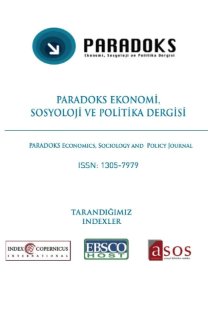Türkiye’de Kadın İstihdamının Geleceği
Bu çalışmada 1988-2012 döneminde Türkiye genelinde, kentsel ve kırsal alanlarda yaşayan evli ve bekar kadınların işgücüne katılımını etkileyen unsurların neler olabileceği ve bu unsurların kadın istihdamını ne yönde etkilediği araştırılmış ve bu faktörlerin etkisinde ülkemizde gelecek yıllarda kadın istihdamının nasıl olacağı öngörülmüştür. Bu amaçla TUİK resmi sitesinden, her bir değişkene ilişkin veriler 1988-2012 dönemi için çalışmanın amacı kapsamında derlenmiş ve analizler yapılmıştır. Analiz sonuçları beklentilere uygun çıkmıştır. Evli kadınların istihdamda daha az yer aldığı ve eğitim durumu ile medeni durumun kadının istihdamı açısından birlikte değerlendirilmesi gerektiği sonuçlarına ulaşılmıştır. Gelecek beş yıllık dönemde ise kadın istihdam oranında düşüş olması öngörülmüş, bu beklentinin sebebi de ülkemizde 2017-2018 döneminde yaşanması beklenen muhtemel kriz olduğu öngörülmüştür.
Anahtar Kelimeler:
Kadın İstihdamını Belirleyen Faktörler, Öngörü
The Future Of Women Employment In Turkey
In this study,what the factors influence the participation in the labour force of married and single women lived in urban and rural areas, were investigated and how these factors affect women’s employment has been investigated and how women employment in the future under the influence of these factors will be predicted. For this aim, data for each variable was compiled for the period 1988-2012 for the purpose of the aim of study from TUİK official site and the analyze was done. Analysis results came in line with expectations. According to these results, married women takes up less space on employment and educational attainment and marital status should be evaluated together in terms of employment. In the next five year period, the decrease in women’s employment is expected, the reason fort his expectation is possible crisis in our country expected to ocur during the period 2017-2018.
Keywords:
Determinants of Women Employment, Forecasting,
___
- Akbulut, Rahşan (2011), “Sectoral Changes and the Increase in Women’s Labor Force Participation”, Maacroeconomic Dynamics15, ss. 240-264.
- Alessandra, Fogli and Laura, Veldkamp (2011), “Nature or Nurture? Learning and the Geograpy of Female Labor Force Participation”, Econometrica, Volume 79, Issue 4, pp. 1103-1138.
- Antecol, H. (2000), “An examination of cross-country differences in the gender gap in labor force participation rates”, Labour Economics, vol. 7(4), pp. 409-426.
- Blau, Francine D. And Kahn, Lawrence M. (2007), “The Gender Pay Gap”, The Economists’ Voice: Vol. 4: Iss. 4, Article 5.
- Claudia, Olivetti (2013), “Shocking Female Labor Supply: A Reassessment of the Impact of World War II on U.S. Women’s Labor Supply”, American Economic Review: Papers &Proceedings, 103(3): pp. 257-262.
- Kakıcı, H., Emeç H., ve Üçdoğruk, Ş. (2007), “Türkiye’de Çalışan Kadınların Çocuk Bakım Tercihleri”, İstanbul Üniversitesi İktisat Fakültesi Ekonometri ve İstatistik Dergisi, 5, ss.20-40.
- Kızılgöl, Özlem (2012), “Kadınların İşgücüne Katılımının Belirleyicileri: Ekonometrik Bir Analiz”, Doğuş Üniversitesi Dergisi, 13(1) ss. 88-101.
- Metin, Berber ve Burçin Yılmaz Eser (2008), “Türkiye’de Kadın İstihdamı: Ülke ve Bölge Düzeyinde Sektörel Analiz”, İş, Güç Endüstri ilişkileri ve İnsan Kaynakları Dergisi Cilt:10 Sayı:2, ISSN: 1303-2860.
- Michelle, Rendall (2011), “The Service Sector and Female Market Work: Europe vs US”, 2011 Meeting Papers 778, Society for Economic Dynamics.
- Orazio, Attanasio, Hamish, Low and Virginia Sanchez-Marcos (2008), “Explaining Changes in Female Labor Supply in a Life-Cycle Model”, American Economic Review, American Economic Association, vol. 98(4), pp. 1517-52.
- Powel, L. (2002), “ Joint Labor Supply and Child Care Choice Decisions of Married Mothers”, Journal of Human Resources, 27(1).
- Sevüktekin, Mustafa (2013), “Ekonometriye Giriş”, Dora Yayıncılık, s. 232.
- Tansel, A. (2001), “İktisadi Kalkınma ve Kadınların İşgücüne Katılımı: Türkiye’den Zaman Serisi Kanıtları ve İllere Göre Yatay Kesit Kestirimleri”, ERC Working Papers in Economics 01/05T.
- ISSN: 1305-7979
- Yayın Aralığı: Yılda 2 Sayı
- Başlangıç: 2005
- Yayıncı: Sema AY
Sayıdaki Diğer Makaleler
Asist.prof. Birgül CAMBAZOĞLU, Assoc. Prof. Hacer Simay KARAALP, Dr. Konstantinos VERGOS
Türkiye’de Kadın İstihdamının Geleceği
Arş.gör. İşın ÇETİN, Prof.dr. Mustafa SEVÜKTEKİN
Süreç İyileştirmenin İşletme Performansına Etkileri
Öğr.gör. Yeşim KAYGUSUZ, Prof.dr. Sait KAYGUSUZ
İtalya’da Endüstrileşme Sürecinde Devletin Rolü Üzerine Bir Tartışma
İhracatta Örgütlenme Modeli Olarak Sektörel Dış Ticaret Şirketleri ve Türkiye’deki İşlevselliği
